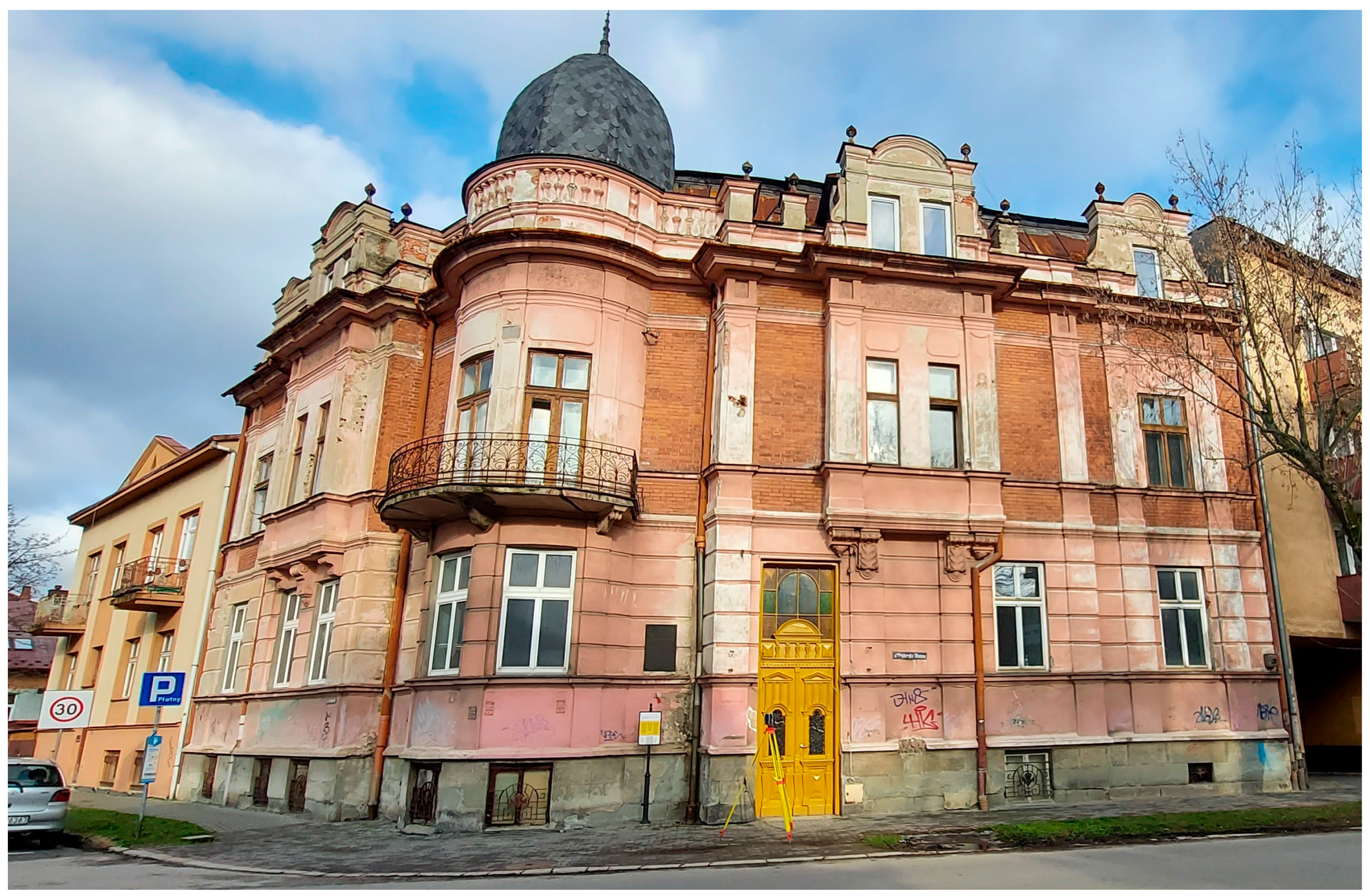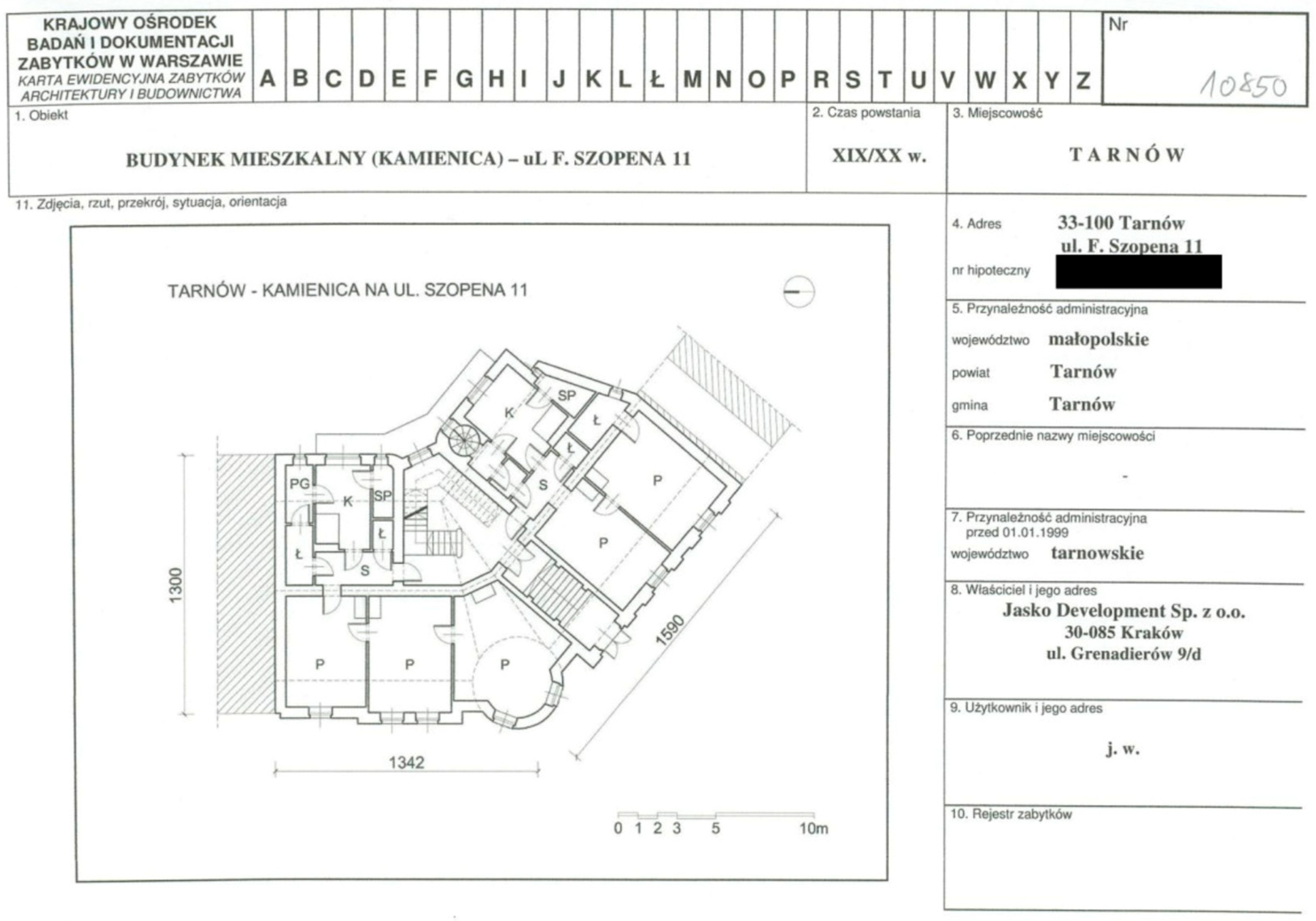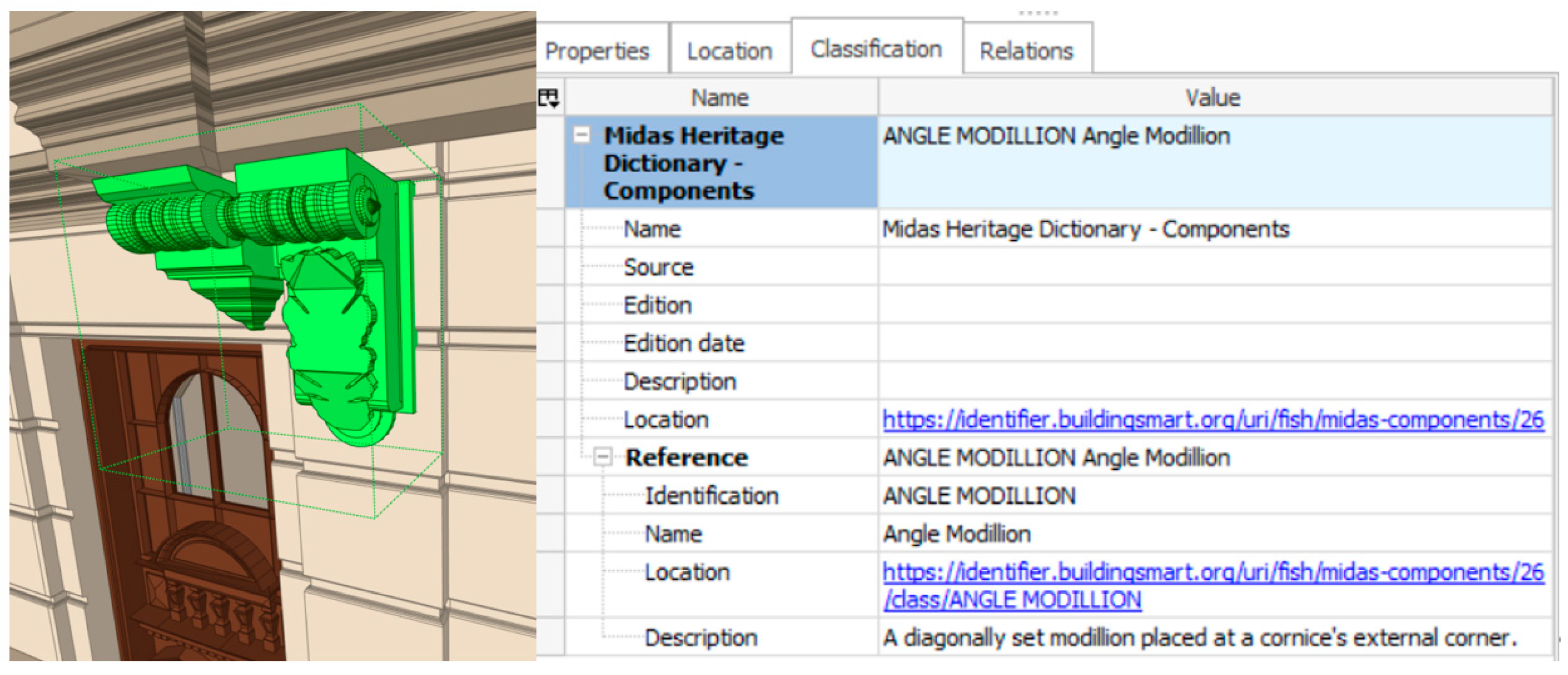Enhancing Semantic Interoperability of Heritage BIM-Based Asset Preservation
Abstract
1. Introduction
2. Materials and Methods
2.1. Synthesis and Further Analysis
2.2. Case Study: Historic Tenement on Chopina Street, Tarnów
3. Results
3.1. Semantic Structuring and Classification
3.2. Tools and Technologies
3.3. Semantic Enrichment of Architectural Components
- IFC entity and type when applicable
- Relevant MIDAS classification reference when applicable:
- Component classification (one of 1397 available classes in the MIDAS Component ontology)
- Construction material (one of 636 available in MIDAS Materials ontology)
- Monument class (one of 7897 available in MIDAS Monument Type ontology)
- Related Property Sets when applicable
- Decorative style (e.g., Neo-Baroque, Secessionist)
- Construction technique
- Condition and historical relevance
- Data source and confidence level
- Historical phase (where identifiable)
- Confidence level in the attribution
3.4. Interoperability and Export
4. Discussion
5. Conclusions
Author Contributions
Funding
Data Availability Statement
Acknowledgments
Conflicts of Interest
Abbreviations
| API | Application Programming Interface |
| BIM | Building Information Modelling |
| bSDD | buildingSMART Data Dictionary |
| CH | Cultural Heritage |
| IFC | Industry Foundation Classes |
| FAIR | Findable, Accessible, Interoperable, Reusable |
| FISH | Forum on Information Standards in Heritage |
| HBIM | Heritage Building Information Modelling |
| MIDAS | MIDAS Heritage—the UK Historic Environment Data Standard |
| OWL | The Web Ontology Language |
| RDF | Resource Description Framework |
| SKOS | Simple Knowledge Organization System |
| TLS | Terrestrial Laser Scanning |
| URI | Uniform Resource Identifier |
References
- Ávila, F.; Blanca-Hoyos, Á.; Puertas, E.; Gallego, R. HBIM: Background, Current Trends, and Future Prospects. Appl. Sci. 2024, 14, 11191. [Google Scholar] [CrossRef]
- Argasiński, K.; Kuroczyński, P. Preservation through digitization—standardization in documentation of build cultural heritage using capturing reality techniques and heritage/historic BIM methodology. Int. Arch. Photogramm. Remote Sens. Spat. Inf. Sci. 2023, XLVIII-M-2-2023, 87–94. [Google Scholar] [CrossRef]
- Industry Foundation Classes (IFC)—buildingSMART International. Available online: https://www.buildingsmart.org/standards/bsi-standards/industry-foundation-classes/ (accessed on 17 September 2025).
- ISO 16739-1:2024; Industry Foundation Classes (IFC) for Data Sharing in the Construction and Facility Management Industries. International Organization for Standardization (ISO): Geneva, Switzerland, 2024. Available online: https://www.iso.org/standard/84123.html (accessed on 10 October 2024).
- buildingSMART Data Dictionary. buildingSMART International. Available online: https://www.buildingsmart.org/users/services/buildingsmart-data-dictionary/ (accessed on 17 September 2025).
- Khan, M.; Khan, M.; Bughio, M.; Talpur, B.; Kim, I.; Seo, J. An Integrated HBIM Framework for the Management of Heritage Buildings. Buildings 2022, 12, 964. [Google Scholar] [CrossRef]
- Monchetti, S.; Betti, M.; Borri, C.; Gerola, C.; Matta, C.; Francalanci, B. Insight on HBIM for Conservation of Cultural Heritage: The Galleria Dell’Accademia Di Firenze. Heritage 2023, 6, 6949–6964. [Google Scholar] [CrossRef]
- Giuliani, F.; Gaglio, F.; Martino, M.; De Falco, A. A HBIM Pipeline for the Conservation of Large-Scale Architectural Heritage: The City Walls of Pisa. Herit. Sci. 2024, 12, 35. [Google Scholar] [CrossRef]
- Gil, A.; Arayici, Y.; Kumar, B.; Laing, R. Machine and Deep Learning Implementations for Heritage Building Information Modelling: A Critical Review of Theoretical and Applied Research. J. Comput. Cult. Herit. 2024, 17, 1–22. [Google Scholar] [CrossRef]
- El Barhoumi, N.; Hajji, R. HBIM and extended reality for cultural mediation of historical heritage: A review. Int. Arch. Photogramm. Remote Sens. Spatial Inf. Sci. 2024, XLVIII-4/W9-2024, 125–132. [Google Scholar] [CrossRef]
- ISO 23386:2020; Building Information Modelling and Other Digital Processes Used in Construction—Methodology to Describe, Author and Maintain Properties in Interconnected Data Dictionaries. International Organization for Standardization (ISO): Geneva, Switzerland, 2020. Available online: https://www.iso.org/standard/75401.html (accessed on 17 September 2025).
- ISO 12006-3:2022; Building construction—Organization of Information About Construction Works. International Organization for Standardization (ISO): Geneva, Switzerland, 2022. Available online: https://www.iso.org/standard/74932.html (accessed on 17 September 2025).
- Kuroczyński, P.; Apollonio, F.I.; Bajena, I.P.; Cazzaro, I. Scientific reference model—Defining standards, methodology and implementation of serious 3D models in archaeology, art and architectural history. Int. Arch. Photogramm. Remote Sens. Spatial Inf. Sci. 2023, XLVIII-M-2-2023, 895–902. [Google Scholar] [CrossRef]
- Scandurra, S.; Di Luggo, A. BSDD to document state of preservation of architectural heritage in open-HBIM systems. Int. Arch. Photogramm. Remote Sens. Spatial Inf. Sci. 2023, XLVIII-M-2-2023, 1427–1434. [Google Scholar] [CrossRef]
- Argasiński, K.; Tomczak, A. Enhancing Semantic Interoperability of Heritage BIM-based Asset Preservation. In Proceedings of the 29th Conference on Cultural Heritage and New Technologies (CHNT), Vienna, Austria, 4–6 November 2024. [Google Scholar]
- Argasiński, K.; Tomczak, A. Klasyfikacja Zasobów Dziedzictwa w Oparciu o Schemat IFC i Otwarte Słowniki Danych bSDD. In Proceedings of the Międzynarodowa Konferencja ETHER Ethernal Heritage/Wieczne Dziedzictwo, Warszawa, Poland, 5–6 November 2024. [Google Scholar]
- Blender—The Free and Open Source 3D Creation Software—Blender.Org. Available online: https://www.blender.org/ (accessed on 17 September 2025).
- Bonsai. Available online: https://extensions.blender.org/add-ons/bonsai/ (accessed on 17 September 2025).
- López, F.J.; Lerones, P.M.; Llamas, J.; Gómez-García-Bermejo, J.; Zalama, E. A Review of Heritage Building Information Modeling (H-BIM). MTI 2018, 2, 21. [Google Scholar] [CrossRef]
- Brusaporci, S. Digital Innovations in Architectural Heritage Conservation: Emerging Research and Opportunities; Advances in Media, Entertainment, and the Arts; IGI Global: Hershey, PA, USA, 2017; ISBN 978-1-5225-2434-2. [Google Scholar]
- FISH Terminologies. Available online: https://heritage-standards.org.uk/fish-vocabularies/ (accessed on 17 September 2025).
- ISO 25964-1:2011; Information and Documentation—Thesauri and Interoperability with Other Vocabularies. International Organization for Standardization (ISO): Geneva, Switzerland, 2011. Available online: https://www.iso.org/standard/53657.html (accessed on 17 September 2025).
- Art & Architecture Thesaurus (Getty Research Institute). Available online: https://www.getty.edu/research/tools/vocabularies/aat/ (accessed on 17 September 2025).
- Doerr, M.; Ore, C.-E.; Stead, S. The CIDOC Conceptual Reference Model—A New Standard for Knowledge Sharing. In Proceedings of the Challenges in Conceptual Modelling. Tutorials, Posters, Panels and Industrial Contributions at the 26th International Conference on Conceptual Modeling—ER 2007, Auckland, New Zealand, 5–9 November 2007. [Google Scholar] [CrossRef]
- Pauwels, P.; Zhang, S.; Lee, Y.-C. Semantic Web Technologies in AEC Industry: A Literature Overview. Autom. Constr. 2017, 73, 145–165. [Google Scholar] [CrossRef]
- Bartalesi, V.; Meghini, C.; Metilli, D. Steps Towards a Formal Ontology of Narratives Based on Narratology. In Proceedings of the 7th Workshop on Computational Models of Narrative (CMN 2016), Kraków, Poland, 11–12 July 2016. [Google Scholar]
- Pauwels, P.; Deursen, D. IFC-to-RDF: Adaptation, Aggregation and Enrichment. In Proceedings of the First International Workshop on Linked Data in Architecture and Construction, Ghent, Belgium, 28–29 March 2012. [Google Scholar]
- Berners-Lee, T.; Hendler, J.; Lassila, O. The Semantic Web: A New Form of Web Content That Is Meaningful to Computers Will Unleash a Revolution of New Possibilities. In Linking the World’s Information; Seneviratne, O., Hendler, J., Eds.; ACM: New York, NY, USA, 2023; pp. 91–103. ISBN 979-8-4007-0794-0. [Google Scholar]
- Klyne, G.; Carroll, J.J.; McBride, B. Resource Description Framework (RDF): Concepts and Abstract Syntax. 2004. Available online: https://www.w3.org/TR/2004/REC-rdf-concepts-20040210/ (accessed on 17 September 2025).
- Resource Description Framework (RDF): Concepts and Abstract Syntax. Available online: https://www.w3.org/TR/rdf10-concepts/ (accessed on 17 September 2025).
- Bajena, I.; Kuroczyński, P. Metadata for 3D Digital Heritage Models. In the Search of a Common Ground. In Proceedings of the Research and Education in Urban History in the Age of Digital Libraries, Munich, Germany, 27–28 March 2023; Münster, S., Pattee, A., Kröber, C., Niebling, F., Eds.; Springer Nature: Cham, Switzerland, 2023; pp. 45–64. [Google Scholar]
- Tibaut, A.; Guerra De Oliveira, S. A Framework for the Evaluation of the Cultural Heritage Information Ontology. Appl. Sci. 2022, 12, 795. [Google Scholar] [CrossRef]
- Bajena, I.P.; Kuroczyński, P. Challenges Faced in Documentation and Publication of 3D Reconstructions of Cultural Heritage: How to Capture the Process and Share the Data? In Proceedings of the International Conference on Cultural Heritage and New Technologies, Vienna, Austria, 2–4 November 2021; Volume 26. [Google Scholar]
- Lygerakis, F.; Kampelis, N.; Kolokotsa, D. Knowledge Graphs’ Ontologies and Applications for Energy Efficiency in Buildings: A Review. Energies 2022, 15, 7520. [Google Scholar] [CrossRef]
- Simeone, D.; Cursi, S.; Acierno, M. BIM Semantic-Enrichment for Built Heritage Representation. Autom. Constr. 2019, 97, 122–137. [Google Scholar] [CrossRef]
- Iadanza, E.; Maietti, F.; Ziri, A.E.; Di Giulio, R.; Medici, M.; Ferrari, F.; Bonsma, P.; Turillazzi, B. Semantic web technologies meet BIM for accessing and understanding cultural heritage. Int. Arch. Photogramm. Remote Sens. Spatial Inf. Sci. 2019, XLII-2/W9, 381–388. [Google Scholar] [CrossRef]
- Bajena, I.; Kuroczyński, P. WissKI 3D Repository as a Tool for the Preservation and Exploration of 3D Models of Cultural Heritage. In eXploRA Virtual Journeys to Discover Inaccessible Heritages; PUBLICA: Alghero, Italy, 2025. [Google Scholar]
- Bajena, I.P. OntPreHer3D: Ontology for Preservation of Cultural Heritage 3D Models. Peer Community J. 2025, 5, XX. [Google Scholar] [CrossRef]
- Fonnet, A.; Alves, N.; Sousa, N.; Guevara, M.; Magalhães, L. Heritage BIM Integration with Mixed Reality for Building Preventive Maintenance. In Proceedings of the 2017 24° Encontro Português de Computação Gráfica e Interação (EPCGI), Guimarães, Portugal, 12–13 October 2017; pp. 1–7. [Google Scholar]
- Heritage Data Standards and Terminology|Historic England. Available online: https://historicengland.org.uk/advice/technical-advice/information-management/data-standards-terminology/ (accessed on 17 September 2025).
- Midas Heritage. Available online: https://heritage-standards.museologi.st (accessed on 17 September 2025).
- Historic England—Championing England’s Heritage|Historic England. Available online: https://historicengland.org.uk/ (accessed on 10 February 2023).
- Zabytek.pl. Available online: https://zabytek.pl/pl/obiekty/dom-(kamienica)-913451/dokumenty/PL.1.9.ZIPOZ.NID_N_12_EN.513516/1 (accessed on 17 September 2025).
- NID|Portal Mapowy. Available online: https://mapy.zabytek.gov.pl/nid/?bbox=641795.77,240415.17,641814.52,240440.47&gpw=4c4db0eb-84dd-45ae-a269-1a1459241d81 (accessed on 17 September 2025).
- BIMfaktoria; Argasiński, K. Inwentaryzacja Zabytkowej Kamienicy w Tarnowie. Usługi Skaningu Laserowego—BIMfaktoria. Available online: https://bimfaktoria.pl/portfolio/inwentaryzacja-zabytkowej-kamienicy-w-tarnowie/ (accessed on 17 September 2025).
- Argasiński, K.; Koszewski, K. Semantic Segmentation as the Essence of Heritage Building Information Modelling. Wiadomości Konserw. J. Herit. Conserv. 2025, 82, 124–139. [Google Scholar] [CrossRef]
- Archicad. Graphisoft. Available online: https://www.graphisoft.com/plans-and-products/archicad (accessed on 17 September 2025).
- About Uniclass|Uniclass. Available online: https://uniclass.thenbs.com/about (accessed on 17 September 2025).
- Scandurra, S.; Lanzara, E.; Improta, I.; Lo Pilato, A.; Itri, F. bSDD for artworks in HBIM open and standard-oriented documentation. Int. Arch. Photogramm. Remote Sens. Spatial Inf. Sci. 2024, XLVIII-2/W4-2024, 397–404. [Google Scholar] [CrossRef]
- Forum on Information Standards in Heritage|bSDD. Available online: https://identifier.buildingsmart.org/uri/fish (accessed on 17 September 2025).
- Angle Modillion|bSDD. Available online: https://identifier.buildingsmart.org/uri/fish/midas-components/26/class/ANGLE%20MODILLION (accessed on 17 September 2025).
- FAIR Principles. GO FAIR. Available online: https://www.go-fair.org/fair-principles/ (accessed on 17 September 2025).
- Neely-Cohen, M. Century-Scale Storage. Available online: https://lil.law.harvard.edu/century-scale-storage (accessed on 17 September 2025).
- Bajena, I.P.; Apollonio, F.I.; Argasiński, K.; Fallavollita, F.; Foschi, R.; Franczuk, J.; Koszewski, K.; Kuroczyński, P.; Lutteroth, J. Documentation and Publication of Hypothetical Virtual 3D Reconstructions in the CoVHer Project. In 3D Research Challenges in Cultural Heritage V: Paradata, Metadata and Data in Digitisation; Ioannides, M., Baker, D., Agapiou, A., Siegkas, P., Eds.; Springer Nature: Cham, Switzerland, 2025; pp. 115–126. ISBN 978-3-031-78590-0. [Google Scholar]
- Croce, V.; Caroti, G.; Piemonte, A.; De Luca, L.; Véron, P. H-BIM and Artificial Intelligence: Classification of Architectural Heritage for Semi-Automatic Scan-to-BIM Reconstruction. Sensors 2023, 23, 2497. [Google Scholar] [CrossRef] [PubMed]







Disclaimer/Publisher’s Note: The statements, opinions and data contained in all publications are solely those of the individual author(s) and contributor(s) and not of MDPI and/or the editor(s). MDPI and/or the editor(s) disclaim responsibility for any injury to people or property resulting from any ideas, methods, instructions or products referred to in the content. |
© 2025 by the authors. Licensee MDPI, Basel, Switzerland. This article is an open access article distributed under the terms and conditions of the Creative Commons Attribution (CC BY) license (https://creativecommons.org/licenses/by/4.0/).
Share and Cite
Argasiński, K.; Tomczak, A. Enhancing Semantic Interoperability of Heritage BIM-Based Asset Preservation. Heritage 2025, 8, 410. https://doi.org/10.3390/heritage8100410
Argasiński K, Tomczak A. Enhancing Semantic Interoperability of Heritage BIM-Based Asset Preservation. Heritage. 2025; 8(10):410. https://doi.org/10.3390/heritage8100410
Chicago/Turabian StyleArgasiński, Karol, and Artur Tomczak. 2025. "Enhancing Semantic Interoperability of Heritage BIM-Based Asset Preservation" Heritage 8, no. 10: 410. https://doi.org/10.3390/heritage8100410
APA StyleArgasiński, K., & Tomczak, A. (2025). Enhancing Semantic Interoperability of Heritage BIM-Based Asset Preservation. Heritage, 8(10), 410. https://doi.org/10.3390/heritage8100410






